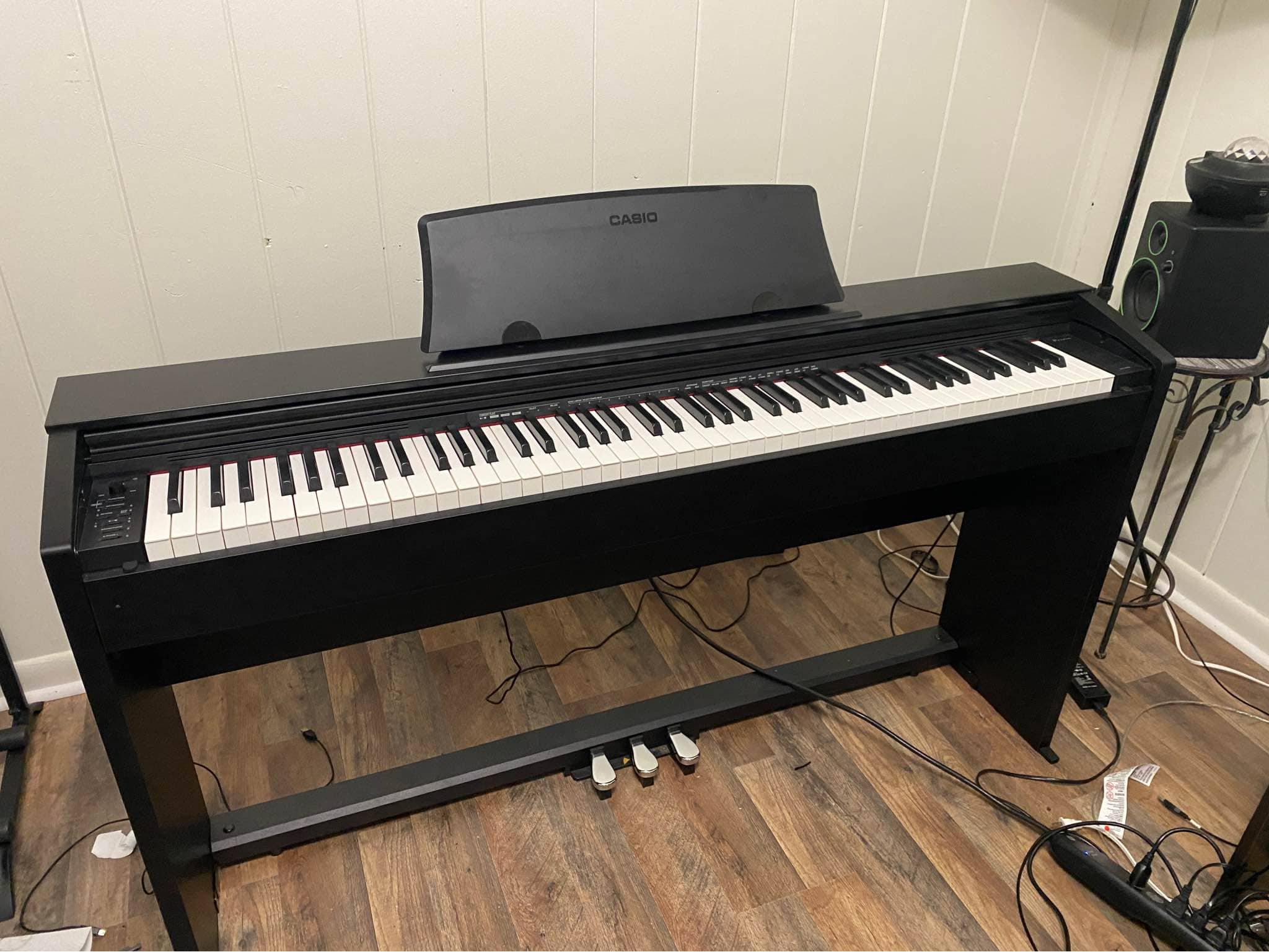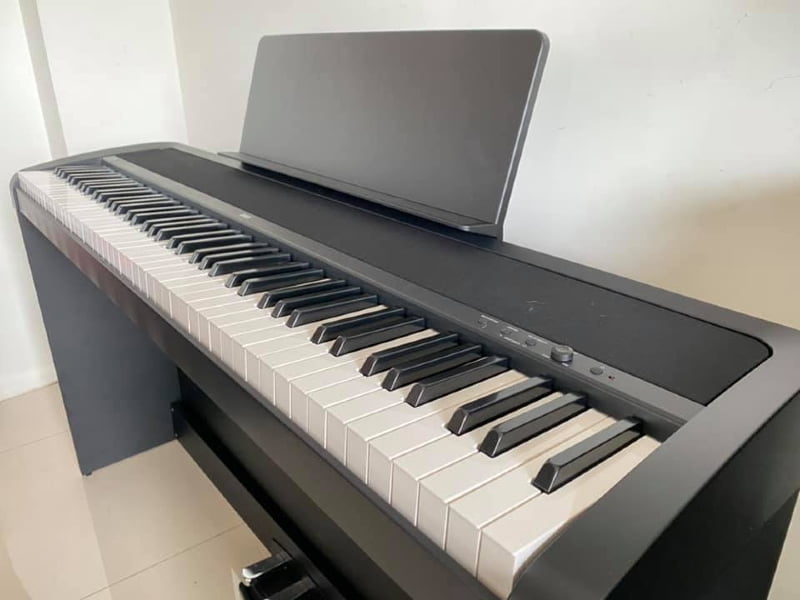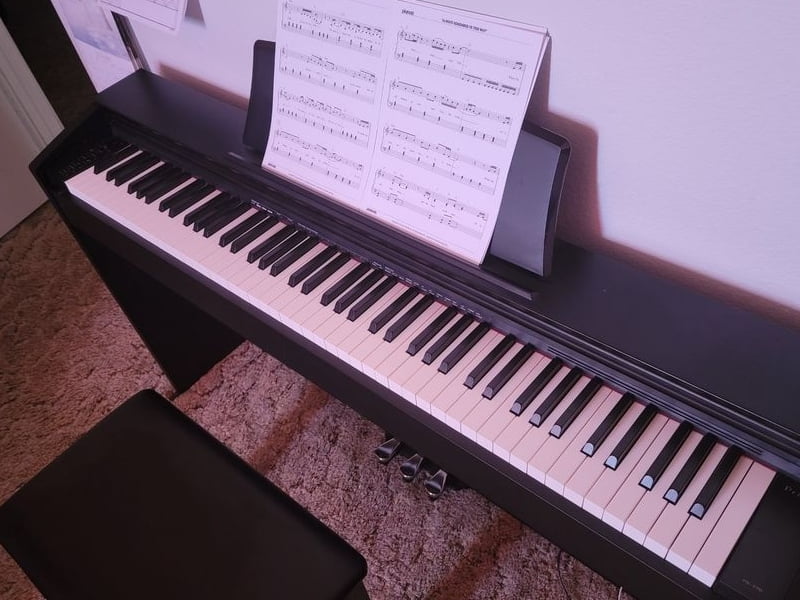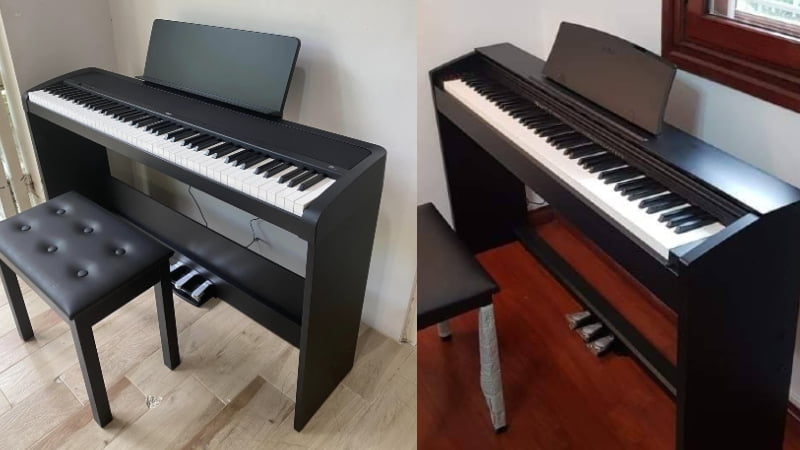Looking for a console piano on a budget? Find out the best one for your needs in this Casio PX-770 vs Korg B2SP review!
Finding a good console digital piano is tough nowadays. There are just so many options out there that it’s easy to get overwhelmed. But if you’re shopping in the sub-$1,000 range, I highly suggest that you check out the Casio PX-770 and the Korg B2SP.
These are some of the best options in this price range and offer a lot of value for the money. And if you’re trying to choose between the two, you’ve come to the right place.
In this Casio PX-770 vs Korg B2SP review, we’re taking a close look at these two pianos. I’ll be dissecting their features and looking at their similarities and differences to help you find the best fit for your needs.
After thorough testing, I determined that the Casio PX-770 edges out a win with its better tones and more realistic piano feel. That said, there are some people that might prefer the Korg B2SP depending on their needs.
So, keep reading to learn all the details of these two pianos and finally figure out which one would be the better pick for you!
Casio PX-770 vs Korg B2SP: Comparison Chart




Last update on 2025-04-14 / Affiliate links / Images from Amazon Product Advertising API
Casio PX-770 vs Korg B2SP: A Head to Head Comparison
There were three main categories that I used to compare these pianos – tone, feel, and the piano features. These are the most important general characteristics of any digital piano and is a great way to figure out which model would be the best for you.
By the end of this comparison, the score was 3-1 in favor of the Casio PX-770. With more realistic tones and a premium feel, it was hard for the Korg B2SP to compete. But as you’ll learn below, the comparison is a bit closer than things might initially seem.
Tone
The winner: Casio PX-770
The first characteristic of the two pianos that I compared was the tone. In my opinion, this should always be the first feature to check out, as you always want a digital piano that sounds good. And because of its better sound library and tone generator, the Casio PX-770 took the point in this comparison.
+Tone Generator
Before I get into the Casio’s tone generator, it’s worth mentioning that the Korg B2SP has a very good tone generator itself. It uses the Stereo PCM tone generator, which relies on high-quality pre-recorded stereo samples of various instruments. When you press a key on the piano, you trigger one of these samples. And compared to other pianos in its price range, the Korg produces much more realistic and detailed voices.
That said, it still couldn’t compete with the AiR generator on the Casio. This is because the AiR tone engine, aside from relying on samples, emulates the way sound waves from a real piano travel through the air. This is why you get a very distinct brightness and realism when playing the Casio that you won’t find in the sub-$1,000 price range.
So, if you’re looking for the best tone quality possible, I recommend the Casio. While it’s a bit more expensive, rest assured that the extra investment will be more than worth it in the long run.

+Sound Library
The Casio also wins out when you compare their sound libraries. Like all digital pianos, both of these models don’t have the widest sound libraries. However, you definitely get more variety with the Casio as it has 19 voices, which is much more than the 12 voices you’ll find on the Korg.
While both sound libraries cover the same types of sounds such as electric and acoustic pianos, strings, bass, and organ voices, you have more choices with the Casio. So, if you want full control over your tone and want to explore various musical styles, you’ll be better off with the Casio.
Feel
The winner: Casio PX-770
Another reason the Casio PX-770 won this comparison was because of the superior piano feel. When playing the Casio PX-770, it felt much more realistic than the Korg B2SP, which is expected since it’s more expensive. This is why if you want a piano that feels as close as possible to an acoustic piano, the Casio PX-770 is worth the extra cost.
+Hammer Action
The Casio model uses the brand’s Smart Scaled Hammer Action system. With this system, you capture the slight weight differences that you feel on the keys of an acoustic piano. This is very important as you can obviously tell that a piano is digital if it has a uniform weight on the keys.
While the Korg’s Natural Weighted Hammer Action looks to replicate this feel as well, it’s evident that it doesn’t do as good of a job. There was something about the Korg’s feel that made it obvious that I was playing a digital piano. And while it was still more realistic than many other digital models, it didn’t compete with the Casio PX-770.
On top of that, the Casio features a set of textured keys. So, not only does it capture the weight of an acoustic piano, but it makes you forget that you’re pressing plastic keys. It would have been nice to see real wooden keys on the piano as well, but that would probably cause the price to skyrocket.

Piano Features
The winner: Tie
The last comparison point I had between the two pianos were the piano features. Particularly, I looked at the polyphony and playing modes of both instruments. While they excelled in terms of polyphony, both pianos were lacking in playing modes. Because of this, I ended up awarding the point to both instruments.
+Polyphony
Both of these pianos feature 128-note polyphony. This means that the instruments can play up to 128 notes at the same time. While you won’t be required to play that many notes when reading sheet music, it comes in handy when you want to add emotion to your playing with the sustain pedal.
With lower polyphony, the pianos wouldn’t sustain the notes as long. However, since both pianos come with 128-note polyphony, you can easily play dense chords and long stretches with the sustain pedal engaged.
+Playing Modes
One of my only qualms with both pianos is that they don’t have the best set of playing modes. Ideally, digital pianos should come with various playing modes to give you flexibility. That said, neither of these pianos comes with the playing modes you’d expect to form a digital piano, which is a huge letdown.
The only additional mode you get with both instruments is lesson mode. This is great for piano duets and lessons as you get to divide the keyboard into two mini pianos. While this is useful, it would have been even better to see more playing modes on these instruments.

Casio PX-770 vs Korg B2SP: The Similarities
While they come from different brands, these pianos share some similarities. For example, they are both console instruments. This means that you won’t be able to bring them around as they are designed to stay in one place for a long time. However, the trade-off is that you get a much better sound and more realistic feel, and you get an instrument that can serve as a home piano.
Another major similarity is that both pianos come with basic piano effects. So, you can add both chorus and reverb effects to your playing, giving you more control over your tone. Granted, the effects could have been done better, but the fact that these budget-friendly pianos even have effects is worth mentioning.
Quick Rundown of the Casio PX-770
- 88 scaled, weighted hammer-action keys with simulated ebony and ivory textures
- Stunning new piano sound with detailed resonance, plus 18 other Tones
- Stereo speaker system built into stylish, modern wooden cabinet
- Versatile practice, performance, and MIDI recording tools
- 3 year manufacturer extended warranty
Last update on 2025-04-14 / Affiliate links / Images from Amazon Product Advertising API
Quick Rundown of the Korg B2
Last update on 2025-04-14 / Affiliate links / Images from Amazon Product Advertising API
Product Video
Related Articles to Casio Px 770
- Casio PX-770 vs Kawai KDP-110: The Best Console Digital Pianos on a Budget?
- Casio PX-770 vs Kawai ES-110: Should You Get A Portable or Console Digital Piano?
- Casio PX-770 vs PX-160: Should You Get A Portable or Console Digital Piano?
- Casio PX-770 vs S1000: Should You Get A Portable or Console Digital Piano?
- Casio PX-770 vs 750: Finding the Best Budget Digital Piano
- Casio PX-770 vs PX-860: Should You Get A Portable or Console Digital Piano?
- Casio PX-770 Vs AP-270: Which Casio Model Wins Out?
- Casio PX-770 Vs 760: Which Is The Better Casio Privia Model?
- Casio PX-770 Vs Yamaha DGX-660: Should You Get A Portable Or Console Digital Piano?
- Casio PX-770 Vs Yamaha YDP-143: Which Is The Better Piano For The Money?
- Casio PX-770 Vs Roland FP-30: Should You Get A Portable or Console Digital Piano?
- Casio PX-770 vs Yamaha YDP-144: Which Is The Better Digital Piano?
- Casio PX-770 Vs 780: What’s The Difference Between These Two Digital Pianos?
- Casio PX-770 Vs 870: Which Casio Console Digital Piano Is Better?
- Yamaha P45 vs Casio PX 770: Should You Get the Portable or Console Digital Piano?
- Yamaha P125 vs Casio PX-770 Review: Why the Yamaha P125 Beats Out the Casio Console Digital Piano
References:
- Casio PX-770: https://www.sweetwater.com/store/detail/PX770BK–casio-privia-px-770-black-finish
- Korg B2SP: https://www.korg.com/ph/products/digitalpianos/b2sp/
Lulacruza is an electronic folk duo operating at the junction of the hypermodern and the ancient. Our music weaves together hypnotic female singing, South American folk instruments and electronic processing, while channeling pulsating waves from the source of creation.
Lalucruza is also a community where you can connect with other music lovers to collaborate, exchange ideas and share knowledge. A platform for who wants to learns the basics of playing piano, guitar, drum masters’ technique, etc.. is the premise of our website.
